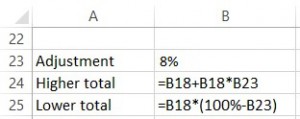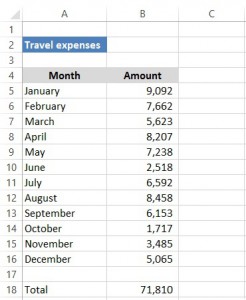Percent amount
But what if you want to see the 8% amount itself, not the new total? The formula in B21 would be:
=B18*0.08
OR
=B18*8%
This is the formula you’d use to calculate sales tax in New York City, if B18 contained the total sale.

While all this math is correct, you might prefer to put the percentage in its own cell, rather than hard-coding it into the formulas. That way, you can change the percentage without having to rewrite the formulas.
If we put the percentage by itself in B23, these formulas would do the trick:

Percent change
Finally, we might want to calculate the percentage change between two numbers. That would give us a clear picture of whether costs were heading up (a positive percentage) or heading down (a negative percentage). In this expense sheet, we’ll calculate the percent change from one month to the next and put the formulas down column C.
The general rule to calculate a percentage change is:
=(new value-old value)/old value
Since January is the first month, it doesn’t have a percentage change. The first change will be in February, so this is the formula for C6:
=(B6-B5)/B5
By default, Excel displays this as a decimal, so click the Percent Style button on the Home tab to format it as a percent. You’ll now see this:

Tip: The keyboard shortcut for Percent Style is Ctrl + Shift + %
Now auto-fill the formula down to the bottom: roll the mouse pointer over the dot in the lower-left corner of the cell that shows -16% and double-click the mouse. That’s a faster way of filling down to the bottom of the column than dragging down.











